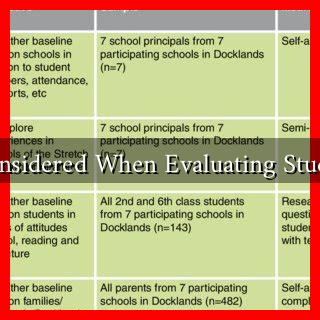-
Table of Contents
What Should Be Considered When Evaluating Students by Objectives?
Evaluating students by objectives is a critical aspect of education that ensures learners meet specific learning goals. This method, often referred to as objective-based assessment, focuses on measuring students’ performance against predetermined standards. However, several factors must be considered to ensure that evaluations are fair, comprehensive, and effective. This article explores these considerations in detail.
Understanding Learning Objectives
Before diving into evaluation methods, it is essential to understand what learning objectives are. Learning objectives are clear statements that describe what students should know or be able to do by the end of a lesson or course. They serve as a roadmap for both educators and students. When evaluating students, the following aspects of learning objectives should be considered:
- Clarity: Objectives should be specific and unambiguous. For example, instead of stating, “Students will understand photosynthesis,” a clearer objective would be, “Students will be able to explain the process of photosynthesis and its importance to plant life.”
- Measurability: Objectives must be measurable to assess student performance effectively. This means they should be framed in a way that allows for quantifiable outcomes.
- Relevance: Objectives should align with broader educational goals and standards, ensuring that they are relevant to students’ future learning and real-world applications.
Types of Assessments
When evaluating students by objectives, the type of assessment used plays a significant role. Different assessment types can yield varying insights into student performance. Here are some common types:
- Formative Assessments: These are ongoing assessments that provide feedback during the learning process. Examples include quizzes, class discussions, and peer reviews.
- Summative Assessments: These assessments occur at the end of an instructional unit and evaluate student learning against the objectives. Examples include final exams, projects, and standardized tests.
- Authentic Assessments: These assessments require students to apply their knowledge in real-world scenarios. For instance, a science project that involves conducting experiments and presenting findings.
Incorporating Diverse Learning Styles
Students have different learning styles, and effective evaluation should consider these differences. According to research by the VARK model, learners can be categorized into four types: Visual, Auditory, Reading/Writing, and Kinesthetic. To accommodate diverse learning styles, educators should:
- Provide various assessment formats, such as written tests, oral presentations, and hands-on projects.
- Encourage collaborative assessments where students can work in groups, allowing for peer learning.
- Utilize technology to create interactive assessments that engage students in different ways.
Feedback Mechanisms
Feedback is a crucial component of the evaluation process. It helps students understand their strengths and areas for improvement. Effective feedback should be:
- Timely: Providing feedback soon after an assessment allows students to reflect on their performance while the material is still fresh in their minds.
- Constructive: Feedback should focus on specific areas for improvement rather than general comments. For example, instead of saying, “You need to improve your writing,” a more constructive comment would be, “Your thesis statement needs to be clearer and more specific.”
- Actionable: Feedback should guide students on how to improve. This could include resources for further study or strategies for better performance in future assessments.
Case Studies and Statistics
Research supports the effectiveness of objective-based evaluations. A study published in the Journal of Educational Psychology found that students who received clear learning objectives and regular feedback performed significantly better than those who did not. Additionally, a survey by the National Center for Education Statistics revealed that 85% of educators believe that objective-based assessments lead to improved student outcomes.
Conclusion
Evaluating students by objectives is a multifaceted process that requires careful consideration of various factors. By understanding learning objectives, utilizing diverse assessment types, accommodating different learning styles, and providing constructive feedback, educators can create a more effective evaluation system. Ultimately, the goal is to foster an environment where students can thrive and achieve their full potential. As education continues to evolve, staying informed about best practices in student evaluation will be crucial for educators aiming to enhance learning outcomes.

